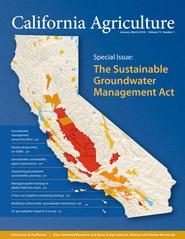All Issues

Map adapted from Figure 2 in Bulletin 118 Interim Update 2016, California DWR. Areas highlighted in yellow, orange and red are, respectively, the medium-priority, high-priority and critically overdrafted groundwater basins subject to regulation under California’s Sustainable Groundwater Management Act of 2014.
Matteo Garbelotto introduces the California Agriculture issue on phytophthora contamination of ecological restoration sites.
Volume 72, Number 1





